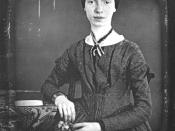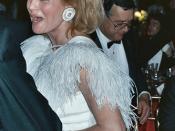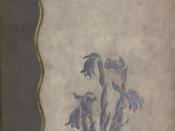Dead Views In the complicated world in which we live, one event remains constant "ÃÂ death. No matter what events occur during our lifetime, death is the eternal given in the equation of life. People around the world all mourn for the deceased; however, people carry out their grief in many different methods. Also, everyone has his or her own views on death. Some believe it should be celebrated, while others think only mourning is appropriate. Some people cry, while others refuse to display their emotions. Emily Dickinson exemplifies two contrasting views of death in "Because I could not stop for Death"ÃÂ and "I heard a Fly buzz "ÃÂwhen I died"ÃÂ through the distinct tones of the poems, the characters in the poems, and the stages of the poems.
"Because I could not stop for Death"ÃÂ depicts death to be celebrated and not feared. The poem describes death as more of a suitor than the grim reaper that most people know him as.
The tone in this poem is a cheerful one. The two lines "Because I could not stop for Death "ÃÂ/ he kindly stopped for me"ÃÂ (1-2) show the way Dickinson portrays death in this poem. The lines illustrate Dickinson's view on death to be an event to look forward to instead of dread. "We slowly drove "ÃÂ He knew no haste/And I had put away/My labor and my leisure too,/For His Civility"ÃÂ (5-8) once again demonstrates Dickinson's opinion on death. In these lines, Dickinson portrays Death as courteous and the event as cheerful instead of chilling. On the other hand, in "I heard a Fly buzz "ÃÂwhen I died"ÃÂ describes death a little more commonly, as something that will happen eventually "ÃÂ the inevitable. The dying woman is waiting for "the King"ÃÂ (7) to appear before her last breath, but instead she sees a fly. The fly appears after "I willed my Keepsakes "ÃÂ Signed away/ What portion of me be/Assignable"ÃÂ (9-11). The fly shows her indifference towards the other mourning people around her. The unusual creature fascinates the dying woman. She becomes so consumed by the fly that she forgets everyone else in the room and can only hear the fly buzzing around her before she dies. The sullen tone is more common and expected as most people expect dying to be instead of the light-hearted tone of the last poem.
Dickinson's different views of death can also be seen through the other character's involvement in the poems. For example, in "Because I could not stop for Death"ÃÂ Dickinson and Death are the only characters on the journey. "The Carriage held but just Ourselves "ÃÂ"ÃÂ (3) shows they are alone in the carriage. She is dying alone, but she celebrates her life as well. As Death carries her through the different stages in her life, she jubilantly awaits to pass into eternity. However, in the other poem "I heard a Fly buzz "ÃÂwhen I died"ÃÂ the fact that others are present is obvious to the reader. "The Eyes around "ÃÂhad wrung them dry --/And Breaths were fathering firm"ÃÂ (5-6) illustrates that the people around her continuously cry because they knew death was rapidly approaching her. They could not cry anymore since they had been crying for so long while she lay on her deathbed. This poem differs from the previous one where the woman graciously awaits death compared to being a mournful event here with everyone crying. The other people around the woman on her deathbed add to the melancholy usually associated with death.
The different stages in the poems also distinguish them from each other. In "Because I could not stop for Death"ÃÂ the poem goes from the woman being picked up in the carriage by Death, through her stages of life, to Eternity. "We passed the School, where Children strove"ÃÂ (9) tells of her childhood. Next, "We passed the Fields of Gazing Grain "ÃÂ/We passed the Setting Sun "ÃÂ"ÃÂ (11-12) shows middle age and older age, respectively. The poem reflects her life in its various stages. The poem starts when she is a child and matures until the present when Death comes to take her away. Finally, the horses are pointed "toward Eternity"ÃÂ (24) at the end of the poem. The woman in the poem has substantial interest for passing into Eternity, almost as she anticipates death. "Because I could not stop for Death"ÃÂ demonstrates one view of death in which one reviews all his or her past accomplishments in life. In "I heard a Fly buzz "ÃÂwhen I died"ÃÂ the stages of the poem go from the woman lying on her deathbed and waiting for the King to appear to paying attention to a fly. As the other people in the room are crying and mourning, the dying woman notices a fly and hears its buzzing sound instead of worrying with materialistic items. The fly captivates her and remains there with her until she finally dies. In the end, she "could not see to see"ÃÂ (15). The woman in the poem struggled to see all she could in life, but at the finale she was unable to see because of her darken vision to see her life and her heavyhearted friends by her side. Ironically, the woman dying chooses to acknowledge a fly buzzing around in her last moments instead of her friends by her deathbed. The stages in the poem reflect Dickinson's varied convictions on death.
The tone of the poems, the characters in the poems, and the stages of the poem display the contrasting views in "Because I could not stop for Death"ÃÂ and "I heard a Fly buzz "ÃÂwhen I died"ÃÂ. By using these two poems, Emily Dickinson effectively compares death as opposites. In these poems, where death is viewed from different perspectives, where the presence of others during death adds to the melancholy of the event, where the dying person's attitude about her life and last moments determine her feelings on death, Dickinson challenges the reader to confront death from two opposing perspectives.





